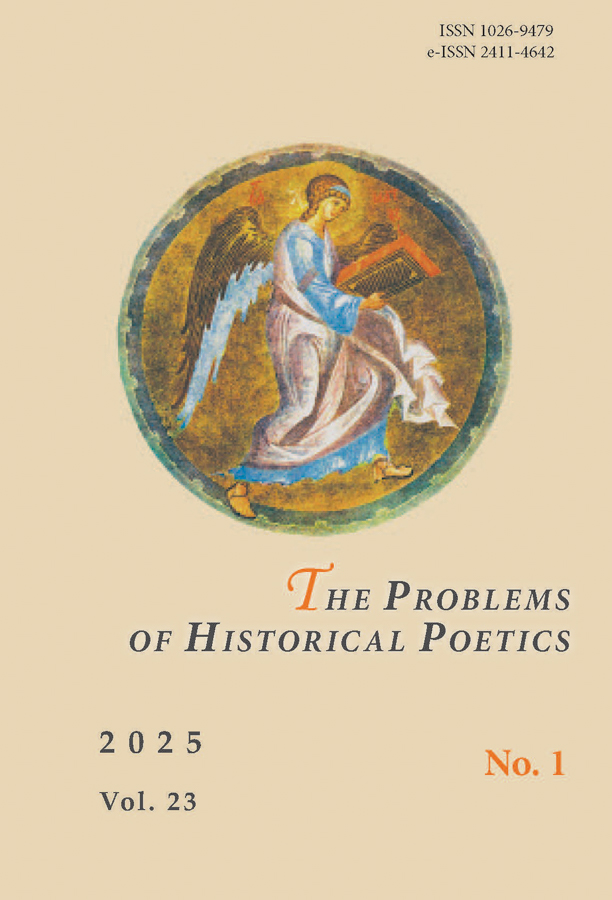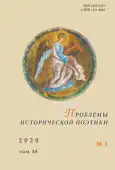A “mathematical” problem in Dostoevsky’s The Raw Youth
- Authors: Sytina Y.N.1
-
Affiliations:
- Moscow Region State University
- Issue: Vol 18, No 3 (2020)
- Pages: 144-170
- Section: Articles
- URL: https://journal-vniispk.ru/1026-9479/article/view/285839
- DOI: https://doi.org/10.15393/j9.art.2020.7742
- ID: 285839
Cite item
Full Text
Abstract
Dostoevsky’s novel The Raw Youth repeatedly refers a reader to mathematics. This fact favors analysis and interpretations of the “mathematical” problem in the novel. Mathematics as an exact science is for Arkady Dolgoruky the main guarantor that his idea of becoming a “Rothschild” is achievable and true. This idea is based on “mathematics”, as it involves the calculation of income. “Mathematical validity” is authoritative for Kraft and other members of Dergachev’s circle,as well as Stebelkov, Lambert, Olya. The plot of the novel is based on “mathematical validity”. It is Katerina Nikolaevna’s fateful letter. The idiom “as simple as twice two makes four” appears six times in The Raw Youth. The debunking of this formula is a characteristic motif for Dostoevsky’s work. The motif of vulnerability of “mathematics” increases with the development of the plot. The Raw Youth’s “mathematical” idea collides with his feelings and impulsive actions. The “mathematical validity” turns out to be irrational. It basis is not logic, but conviction. The opposition to “mathematics” and rationality is “living life” in Dostoevsky’s work. It contributes to the rebirth of Arkady Dolgoruky. He evolves from Rothschild to Christ, from accumulation to self- sacrifice, from Law to Grace.
About the authors
Yuliya N. Sytina
Moscow Region State University
Author for correspondence.
Email: yulyasytina@yandex.ru
PhD of Philology, Associate Professor of the Russian Classic Literature Department
Russian Federation, MoscowReferences
- Bakhtin M. M. The Problems of Dostoevsky’s Poetics. In: Bakhtin M. M. Sobranie sochineniy: v 7 tomakh [Bakhtin M. M. Collected Works: in 7 Vols]. Moscow, Yazyki slavyanskoy kul’tury Publ., 2002, vol. 6, pp. 6–300. (In Russ.)
- Belov S. V. The Numbers in Dostoevsky’s Work. In: Teleskop, 2014, no. 3 (105), pp. 31–32. (In Russ.)
- Bortnes J. “Christ the Father: Styding the Problem of Contrasting Father in Blood and Father at Law in Fedor Dostoevsky’s Novel the Adolescent. In: Problemy istoricheskoy poetiki [The Problems of Historical Poetics]. Petrozavodsk, PetrSU Publ., 1998, vol. 5, pp. 409–415. Available at: http://poetica.pro/journal/article.php?id=2533 (accessed on November 18, 2019). doi: 10.15393/j9.art.1998.2533 (In Russ.)
- Vetlovskaya V. E. Roman F. M. Dostoevskogo «Brat’ya Karamazovy» [F. M. Dostoevsky’s Novel “The Brothers Karamazov”]. St. Petersburg, Pushkinskiy Dom Publ., 2007. 640 p. (In Russ.)
- Viktorovich V. A. The Novel of Knowledge and Faith. In: Roman F. M. Dostoevskogo «Podrostok»: vozmozhnosti prochteniya [Fedor Dostoevsky’s Novel “The Adolescent”: Possible Reading Interpretations]. Kolomna, Kolomna State Pedagogical Institute Publ., 2003, pp. 17–27. (In Russ.)
- Garicheva E. A. Transfiguration of Personality in F. M. Dostoevsky’s Novel “The Adolescent”. In: Problemy istoricheskoy poetiki [The Problems of Historical Poetics], 2011, vol. 9, pp. 201–215. Available at: http://poetica.pro/files/redaktor_pdf/1430312600.pdf (accessed on November 18, 2019). DOI: 10.15393/ j9.art.2011.317 (In Russ.)
- Dukkon A. The Dialogue Between Texts: Vissarion Belinsky’s “Voice” in Fedor Dostoevsky’s “Notes from the Underground”. In: Kul’tura i tekst, 2013, no. 1 (14), pp. 4–28. (In Russ.)
- Esaulov I. A. Spektr adekvatnosti v istolkovanii literaturnogo proizvedeniya («Mirgorod» N. V. Gogolya) [The Spectrum of Adequacy in the Interpretation of a Literary Work (N. V. Gogol’s “Myrgorod”)]. Moscow, The Russian State University for the Humanities Publ., 1995. 100 p. (In Russ.)
- Esaulov I. A. Easter Archetype in Fedor Dostoevsky’s Poetics. In: Problemy istoricheskoy poetiki [The Problems of Historical Poetics], 1998, vol. 5, pp. 349–362. Available at: http://poetica.pro/journal/article.php?id=2526 (accessed on November 18, 2019). doi: 10.15393/j9.art.1998.2526 (In Russ.)
- Esaulov I. A. Paskhal’nost’ russkoy slovesnosti [Paskhal’nost’ of Russian Literature]. Moscow, Krug Publ., 2004. 560 p. (In Russ.)
- Esaulov I. A. The Opposition of Law and Grace and the Main Path of Russian Literature. In: Russkaya klassicheskaya literatura v mirovom kul’turno- istoricheskom kontekste [Russian Classical Literature in a World Cultural and Historical Context]. Moscow, Indrik Publ., 2017, pp. 13–42. (In Russ.) (а)
- Esaulov I. A. “Crime and Punishment”: Explanation, Interpretations, Understanding. In: Mundo Eslavo, 2017, no. 16, pp. 73–81. (In Russ.) (b)
- Esaulov I. A., Sytina Yu. N. Explanation, Interpretation and Understanding in the Study and Teaching of Literature. In: Vestnik Voronezhskogo gosudarstvennogo universiteta. Seriya: Filologiya. Zhurnalistika [Proceedings of Voronezh State University. Series: Philology. Journalism], 2019, no. 2 (42), pp. 21–25. (In Russ.)
- Zakharov V. N. The Symbolism of Christian Calendar in Fedor Dostoevsky’s Works. In: Novye aspekty v izuchenii Dostoevskogo [New Aspects of Dostoevsky Studies]. Petrozavodsk, Petrozavodsk State University Publ., 1994, pp. 37–49. (In Russ.)
- Zakharov V. N. Christian Realism in Russian Literature (Problem Statement). In: Problemy istoricheskoy poetiki [The Problems of Historical Poetics], 2001, vol. 6, pp. 5–20. Available at: http://poetica.pro/journal/article.php?id=2511 (accessed on November 18, 2019) doi: 10.15393/j9.art.2001.2511 (In Russ.)
- Zakharov V. N. What is Two Times Two? Or When the Obvious Is Anything but Obvious in Dostoevsky’s Poetics. In: Voprosy filosofii, 2011, no. 4, pp. 109—114. (In Russ.)
- Zakharov V. N. Creative Process as the Discovery of the Word. In: Polnoe sobranie sochineniy: kanonicheskie teksty [Dostoevsky F. M. The Complete Works: Canonical Texts]. Petrozavodsk, Petrozavodsk State University Publ., 2015, vol. 11, pp. 566–576. (In Russ.)
- Kunilskiy A. E. About the Origins of the Concept “Alive Life” in Dostoevsky’s Works. In: Vestnik Novgorodskogo gosudarstvennogo universiteta imeni Yaroslava Mudrogo [Vestnik of Yaroslav the Wise Novgorod State University], 2007, vol. 44, pp. 72–75. (In Russ.)
- Kustovskaya M. A. The Concept of “Living Life” in Dostoevsky’s Works. In: Problemy istoricheskoy poetiki [The Problems of Historical Poetics], 2011, vol. 9, pp. 169–179. Available at: http://poetica.pro/files/redaktor_pdf/1430310908. pdf doi: 10.15393/j9.art.2011.314 (accessed on November 18, 2019). (In Russ.)
- Lunde I. From the Idea to the Ideal: The Study of One Symbol in Fedor Dostoevsky’s Novel “The Adolescent”. In: Problemy istoricheskoy poetiki [The Problems of Historical Poetics], 1998, vol. 5, pp. 416–423. Available at: http://poetica.pro/journal/article.php?id=2535 (accessed on November 18, 2019). doi: 10.15393/j9.art.1998.2535 (In Russ.)
- Maskevich E. D., Tikhomirov B. N. The Teen Years of Mikhail and Fedor Dostoevsky (New Archival Materials of 1837–1839). In: Neizvestnyy Dostoevskiy [The Unknown Dostoevsky], 2019, no. 2, pp. 56–93. Available at: http://unknown-dostoevsky.ru/files/redaktor_pdf/1562749532.pdf (accessed on November 18, 2019). doi: 10.15393/j10.art.2019.3981 (In Russ.)
- Medvedev A. A. The Symbolism of Slanting Rays in F. M. Dostoevsky’s Works and the Orthodox Liturgical Tradition. In: Kontekst–2008. Moscow, A. M. Gorky Institute of World Literature of the Russian Academy of Sciences Publ., 2009, pp. 18–46. (In Russ.)
- Merezhkovskiy D. S. L. Tolstoy and Dostoevsky. Moscow, Nauka Publ., 2000. 587 p. (In Russ.)
- Neychev N. Tainstvennaya poetika F. M. Dostoevskogo [F. M. Dostoevsky’s Mysterious Poetics]. Yekaterinburg, Ural Federal University Publ., 2010. 316 p. (In Russ.)
- Syzranov S. V. “Life Is an Artistic Work of the Creator…”: On the Artistic Concept of Life in F. M. Dostoevsky’s “The Raw Youth”. In: Vestnik Chelyabinskogo gosudarstvennogo universiteta [Bulletin of Chelyabinsk State University], 2008, no. 26, pp. 141–149. (In Russ.)
- Syrovatko L. V. “The Raw Youth”: A Novel About an Idea. In: Roman F. M. Dostoevskogo «Podrostok»: vozmozhnosti prochteniya [Fedor Dostoevsky’s Novel “The Adolescent”: Possible Reading Interpretations]. Kolomna, Kolomna State Pedagogical Institute Publ., 2003, pp. 63–81. (In Russ.)
- Sytina Yu. N. “Two Times Two Is Mathematics. Try to Argue”: The Objections of Dostoevsky and of the Russian Classics. In: Dostoevskiy i mirovaya kul’tura: Al’manakh [Dostoevsky and World Culture: Almanac]. St. Petersburg, Serebryanyy vek Publ., 2018, vol. 36, pp. 47–55. (In Russ.) (a)
- Sytina Yu. N. “Rus’, Where Are You Racing to?”: from a Bird-Troika to a Railway (Gogol, Dostoevsky and Others). In: Problemy istoricheskoy poetiki [The Problems of Historical Poetics], 2018, vol. 16, no. 4, pp. 115–139. Available at: http://poetica.pro/files/redaktor_pdf/1544616282.pdf (accessed on November 18, 2019). doi: 10.15393/j9.art.2018.5601 (In Russ.) (b)
- Sytina Yu. N. The Formula “Two Times Two Is Four” in the Russian Classics and Its Possible Origins. In: Dva veka russkoy klassiki [Two Centuries of Russian Classics], 2019, vol. 1, no. 1, pp. 128–147. (In Russ.) (a)
- Sytina Yu. N. On Some Features of Dostoevsky’s “Arithmetic”. In: Vestnik Russkoy khristianskoy gumanitarnoy akademii [Herald of the Russian Christian Institute for Humanities], 2019, vol. 20, no. 2, pp. 287–299. (In Russ.) (b)
- Tarasov B. N. Metaphysics of Money in the Works of Honoré de Balzac and Fedor Dostoevsky. In: Problemy istoricheskoy poetiki [The Problems of Historical Poetics], 2015, vol. 13, pp. 198–233. Available at: http://poetica.pro/files/redaktor_pdf/1449821477.pdf (accessed on November 18, 2019). doi: 10.15393/j9.art.2015.3121 (In Russ.)
- Toporov V. N. On the Structure of Dostoevsky’s Novel in Connection with the Archaic Schemes of Mythological Thinking (“Crime and Punishment”). In: Toporov V. N. Mif. Ritual. Simvol. Obraz: issledovaniya v oblasti mifopoeticheskogo [Toporov V. N. Myth. The Ritual. The Symbol. Image: Research in the Field of Mythopoetics]. Moscow, Progress — Kul’tura Publ., 1995, pp. 193–258. (In Russ.)
- Fridlender G. M. An Introductory Note to Comments. In: Dostoevskiy F. M. Polnoe sobranie sochineniy: v 30 tomakh [Dostoevsky F. M. The Complete Works: in 30 Vols]. Moscow, Academy of Sciences of the USSR Publ., 1976, vol. 17, pp. 256–394. (In Russ.)
- Zakharov V. N. What Is Two Times Two? Or When the Obvious Is Anything but Obvious in Dostoevsky’s Poetics. In: Russian Studies in Philosophy, 2011, vol. 50 (3), pp. 24–33. (In English)
Supplementary files











